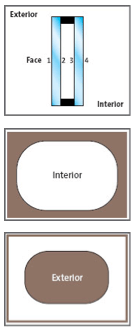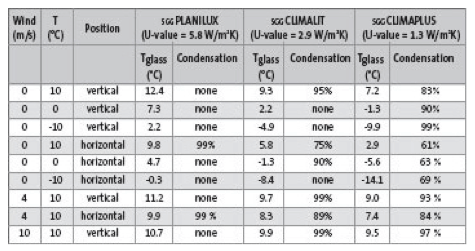Condensation
The phenomenon of surface condensation on double-glazed units occurs in three forms:
- On the external face (face 1)
- On the inner surfaces 2 and 3 of the double-glazed unit
- On the internal face or face 4.
Condensation forms very differently depending on whether it is inside or outside the building, due to the thermal bridge effect around the cavity.
Surface condensation on the internal face always starts in the corners, mainly due to the additional cooling caused by the thermal bridge. “Warm-edge” spacerbars, made of insulating material, reduce the risk of condensation at the corners.
Surface condensation on the external face rarely occurs in the corners, given that the edges of the external glass heat up adjacent to the thermal bridge. The coldest point on the external face of the glazing is generally in the centre, where there is the least heat loss.

Condensation On The Internal Face
The phenomenon of surface condensation on face 4 of a double glazed unit is mainly linked to the following factors:
- The external climate
- The internal air temperature
- Humidity within the building
- The ventilation flow rate
- The surface temperature of the glass To limit condensation, it is advisable to control each of the above parameters, with the exception of the external climate, which is ever-changing.
The best way to reduce surface condensation on the internal face is to collect the water vapour at source (for example in the kitchen or bathroom) and evacuate it straight outside. It is also advisable to heat and ventilate the premises adequately.
It is also possible to reduce the risk of condensation by using a “warm-edge” spacer bar.
Condensation On The External Face
Surface condensation will appear on face 1 of the insulating glazing if the temperature on this face of the glazing is significantly lower than the external air temperature and if the dew point
(i.e. temperature at which water vapour becomes liquid) of the external air is higher than the temperature of the glass.
The surface temperature on the outside of glazing is dependent on:
- The heat flow from the interior passing through the glass. This depends on the difference in temperature between the internal surface and the external surface of the glazing and the U-value of the glass
- The heat exchange by convection with the external air
- Heat loss by radiation mainly to the sky.
Various studies and measurements carried out by the CSTC have shown that heat exchange by radiation is relatively limited in overcast weather. However, when the sky is clear at night, there are significant heat losses to the sky.
The effect of radiation from a glazed surface to the sky can be compared with a car parked outdoors at night in clear (cloudless) weather: in the morning, some parts of its outer surface are wet, or even covered in frost, even if it has not rained. When the car is parked alongside a building, the windows on the building side are never wet, because the building significantly reduces the heat exchange by radiation between the car windows and the sky.
This table shows that:
- The surface temperature of single-glazing is almost never lower than the external air temperature, so condensation rarely occurs on the external face
- Improving the thermal insulation (lower U-value) reduces the transfer of heat to the external surface: the external glazed surface is therefore colder, increasing the risk of condensation.
- When there is a high wind speed, the temperature of the glass tends to be similar to that of the external air
- The cooler the external air, the less likely the glazing is to have a significantly lower temperature than that of the external air.
In conclusion, surface condensation on the outside of glazing is a phenomenon that is occasionally seen at night and in the early hours of the morning on well-insulated glass in clear (cloudless) weather and when there is no wind. This is mainly caused by heat losses towards the clear sky.
It is important that this phenomenon is not considered to represent poor quality double glazed units, but rather proof of good thermal insulation.

Condensation on inner faces 2 and 3
Note
Temporary condensation occurring:
- In periods of high humidity
- In areas where there are short, heavy spells of humidity (e.g. bathrooms)
- During exceptionally cold weather
- Is normal. This condensation should not be permanent.
- Large amounts of water are required when using building materials such as concrete, plaster, grouting and tiles during the renovation or construction of a building. As these materials dry, temporary abnormally damp climates are created inside buildings (occasionally lasting more than a year) during which time the risk of condensation is abnormally high.
- Using an aluminium spacerbar in a double-glazed unit can cause a thermal bridge effect. The unfavourable effect of this thermal bridge will be even greater the higher the degree of insulation of the insulating glazing in the central part (low central U [W/m2K]) and the higher the thermal performance of the frame in which it is inserted (low Uf [W/m2K]). Warm Edge spacer bar which significantly reduces this edge effect.
- Confined spaces: Even in well-ventilated and/or heated premises, the confined spaces can be created, causing localised abnormally humid climates (e.g. the space between an external frame and a curtain, decorations or furniture near windows etc). The risk of condensation in this instance can be abnormally high.
What is condensation?
When does condensation occur?
Condensation on the external surfaces of an insulating glass unit can form in a wide variety of circumstances and on either the inside or the outside of a building.
Indoor condensation
Causes:
The principal cause of condensation on glass on the inside of a building is a high internal humidity level coupled with a low outside temperature which cools the inside surface to below the dew point. Bathrooms, kitchens and other areas where humidity levels are high are particularly susceptible to this problem.
In order to control this form of condensation, consideration should be given to improving the heating and ventilation in these areas. However, another way to reduce the problem is to use high performance windows containing an enhanced thermally insulating glass.
Thermally insulating glass
Condensation forms on the outdoor surface of glass when its temperature drops below the outdoor dew point temperature.
Insulating units containing an energy efficient, low-emissivity glass have enhanced thermal insulation properties thanks to a high performance transparent coating that reflects heat back into the room. As a result the outer pane of glass does not get warmed by heat escaping from inside the building through the glass and remains cooler in comparison to less thermally efficient windows.
External condensation only occurs in certain climatic conditions with high humidity levels and/or particularly cold weather. It is possible that, external condensation will appear on some windows but not on others. This is due to localised atmospheric conditions such as shelter from nearby trees or buildings, variable air currents and wind speeds and varying levels of nearby vegetation.
Condensation on the outdoor surface of such high performance windows is in no way an indication of a defective unit. Indeed, this can be seen as a positive indication that the enhanced thermally insulating units are actively reducing heat loss through the glass.

